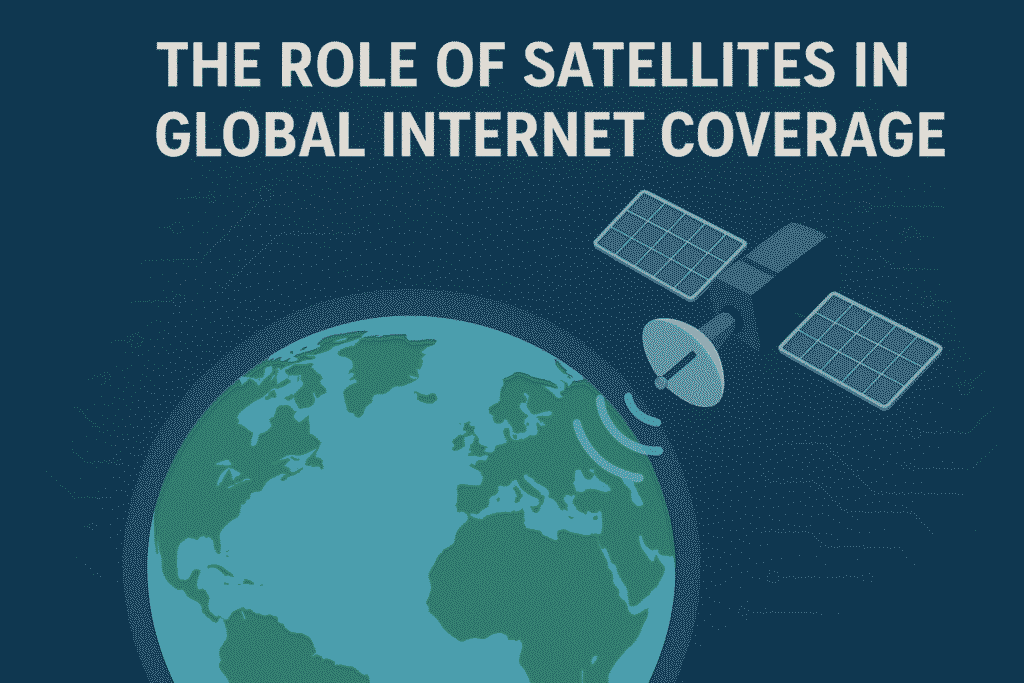
Table of Contents
In the 21st century, the internet has evolved from a luxury to a fundamental utility, as critical to modern life as electricity or running water. It is the backbone of global commerce, education, healthcare, and social interaction. Yet, for all its pervasive influence, a stark digital divide persists. According to the International Telecommunication Union (ITU), nearly one-third of the global population—approximately 2.6 billion people—remain offline. The majority of these individuals live in remote, rural, or topographically challenging regions where laying fiber-optic cable is economically unviable or physically impossible.
For decades, this divide seemed an intractable problem. However, a revolution is now underway, not on the ground, but in the skies above us. Satellites, once primarily used for television broadcasting and government communications, are poised to become the great equalizer in global connectivity. This article delves into the transformative role of satellite technology in providing global internet coverage, exploring its mechanisms, key players, immense benefits, significant challenges, and the promising future it holds for a truly connected planet.
How Satellite Internet Works: The Cosmic Data Relay
At its core, satellite internet is a wireless connection that uses radio waves to communicate with satellites orbiting the Earth. This process creates a complex but efficient celestial data relay system.
The basic mechanism involves three primary steps:
- Uplink: A user’s satellite dish (located at their home or business) sends a signal containing data requests (e.g., loading a webpage, streaming a video) up to a specific satellite in space.
- Satellite Processing: The receiving satellite amplifies the signal, changes its frequency to avoid interference, and beams it back down to Earth.
- Downlink: The signal is received by a large, ground-based station known as a Network Operations Center (NOC) or gateway earth station. This station is directly connected to the global internet backbone via high-speed terrestrial fiber. The NOC processes the request, fetches the data from the internet, and sends it back up to the satellite, which then transmits it down to the user’s dish, completing the cycle.
This entire process, which involves traveling tens of thousands of kilometers into space and back twice, happens in a matter of milliseconds. The key components enabling this are:
- The Satellite Constellation: A network of satellites working in concert.
- Ground Gateways (NOCs): The critical link between the space-based network and the terrestrial internet.
- User Equipment: A phased-array antenna (a flat, pizza-sized dish) and a modem that handles signal transmission and reception.
Types of Satellites and Their Roles: LEO, MEO, and GEO
Not all satellites are created equal. Their altitude and orbit define their capabilities, strengths, and weaknesses. The three primary categories are:
1. Geostationary Earth Orbit (GEO) Satellites
Positioned at an altitude of approximately 35,786 kilometers (22,236 miles) directly above the equator, GEO satellites orbit at the same speed as the Earth’s rotation, making them appear stationary in the sky. This allows a single satellite to provide a permanent “footprint” covering nearly a third of the planet.
- Advantages: Wide, stable coverage; well-established technology.
- Disadvantages: The immense distance creates high latency (the delay in data transmission), typically between 600-800 milliseconds. This makes real-time applications like online gaming, video calls, and VPN use frustratingly slow. Furthermore, signal strength can be weaker over extreme latitudes.
2. Medium Earth Orbit (MEO) Satellites
Residing at altitudes between 2,000 and 35,786 km, MEO satellites strike a balance between coverage and latency. They are most famously used for global positioning systems (GPS and Galileo).
- Advantages: Lower latency than GEO (around 125-150ms); good coverage.
- Disadvantages: Requires a larger constellation than GEO to provide continuous coverage, as each satellite is visible for a shorter period.
3. Low Earth Orbit (LEO) Satellites
This is the new frontier of satellite internet. LEO satellites operate much closer to Earth, at altitudes between 160 and 2,000 km. This proximity drastically reduces latency to between 20-40ms, rivaling or even beating some terrestrial broadband connections.
- Advantages: Very low latency, high-speed potential, and improved signal strength.
- Disadvantages: Because they are so close to Earth, their coverage area is small. To provide continuous global coverage, they require a “constellation” of thousands of satellites working in unison, like a mesh network in the sky. This represents a massive logistical and financial undertaking.
Key Players in the Satellite Internet Market
The race to dominate the new “space race” for internet connectivity is being led by a mix of ambitious private companies and established telecommunications giants.
SpaceX (Starlink)
The undisputed leader in the LEO revolution. Founded by Elon Musk, Starlink has already launched over 5,000 satellites and has well over 2.5 million customers worldwide. Its strategy relies on a massive constellation (with permission for tens of thousands more satellites), frequent rocket launches using reusable Falcon 9 boosters, and a rapidly expanding network of ground gateways. Starlink has demonstrated crucial utility in conflict zones and natural disasters, proving the viability of its technology.
OneWeb
Another major LEO contender, OneWeb focuses primarily on enterprise, government, and maritime/aviation markets rather than direct-to-consumer. After emerging from bankruptcy in 2020, it is now backed by the UK government and Indian telecom giant Bharti Global. Its constellation is complete and operational, providing global coverage.
Amazon (Project Kuiper)
The sleeping giant finally stirring. Amazon has plans to deploy a massive constellation of over 3,200 LEO satellites. While it has been slower to launch than Starlink, Amazon’s immense resources, existing AWS cloud infrastructure, and global logistics network make it a formidable future competitor. Its prototype satellites have demonstrated successful tests of high-throughput capabilities.
Traditional GEO Providers (Viasat, HughesNet)
These companies have provided satellite internet for years using fewer, more powerful GEO satellites. While they struggle with high latency, they are not standing still. They are launching next-generation high-throughput satellites (e.g., Viasat-3) that promise significantly higher speeds and more data capacity, aiming to retain their market share in areas where LEO is not yet available.
Applications and Benefits: More Than Just Streaming
The implications of ubiquitous satellite internet extend far beyond allowing someone to stream movies in a rural cabin. It is a catalyst for global development and security.
- Bridging the Digital Divide: This is the primary mission. Satellite internet can connect remote villages, isolated indigenous communities, and developing nations without the need for a decade-long, multi-billion-dollar ground infrastructure project. It enables remote education, giving students access to global knowledge resources, and telemedicine, allowing doctors in urban centers to consult with patients and local practitioners in remote clinics.
- Disaster Response and Resilience: When terrestrial infrastructure is destroyed by hurricanes, earthquakes, or wildfires, satellite internet becomes a lifeline. First responders can coordinate efforts, and affected communities can communicate with the outside world. Starlink terminals were famously rushed to Ukraine following the Russian invasion, maintaining critical government and civilian communications.
- Support for Critical Mobility Industries: The maritime and aviation industries have long relied on expensive, slow satellite connections. LEO constellations promise to bring high-speed, low-latency internet to cargo ships, cruise liners, and commercial airliners, transforming logistics, safety, and passenger experience.
- Enabling the Global Internet of Things (IoT): Satellite networks can connect millions of sensors deployed across the globe—in agriculture for precision farming, in environmental science for climate monitoring, and in logistics for tracking assets across oceans and deserts, creating a truly interconnected planetary nervous system.
Challenges and Limitations: The Hurdles to Overcome
Despite its promise, the path to a satellite-connected world is fraught with obstacles.
- High Costs: While launch costs are decreasing thanks to reusable rockets, developing, launching, and maintaining a constellation of thousands of advanced satellites remains astronomically expensive. For users, the initial cost of the antenna and modem, though decreasing, is still a barrier for many in low-income regions.
- Latency and Weather Sensitivity: While LEO has solved the latency problem of GEO, all satellite internet remains susceptible to weather. Heavy rain, snow, and thick storm clouds can absorb and scatter the radio waves, causing signal degradation or temporary outage—a phenomenon known as “rain fade.”
- The Space Debris Crisis: The proliferation of mega-constellations has raised serious concerns among astronomers and scientists. Thousands of new satellites increase the risk of catastrophic collisions, creating more debris and potentially triggering the feared Kessler Syndrome—a cascade of collisions that could render certain orbits unusable. Light pollution from satellites also interferes with ground-based astronomical observations.
- Regulatory and Spectrum Hurdles: Operating a global network requires navigating a complex web of international regulations. Companies must secure permission to operate in each country and coordinate with others to use limited radio frequency spectrum to avoid harmful interference.
Technological Advancements: Paving the Way Forward
Innovation is rapidly addressing these challenges:
- Advanced Antennas: User terminals are employing phased-array technology, which uses a grid of tiny antennas to electronically steer beams toward moving satellites without any physical movement, making them more reliable and efficient.
- Laser Inter-Satellite Links (LISL): The next generation of satellites features optical lasers that allow them to communicate with each other directly in space. This creates a high-speed data backbone in orbit, reducing reliance on ground stations and allowing data to be routed across the globe with incredible speed.
- Satellite Miniaturization and Mass Production: Companies like SpaceX have moved from building bespoke satellites to mass-producing them on an assembly line, dramatically reducing unit costs and increasing deployment speed.
- Advanced Debris Mitigation: There is a growing focus on sustainability. New standards include designing satellites for full maneuverability, deorbiting at end-of-life, and using materials that fully burn up during re-entry.
Future Prospects: The Integrated Connectivity Ecosystem
The future of satellite internet is not about replacing fiber or 5G, but about integrating with them. We are moving towards a seamless connectivity fabric where your device will automatically switch between the best available network—be it terrestrial 5G, Wi-Fi, or satellite—without you ever noticing.
- Direct-to-Cell Technology: Companies are already successfully testing technology that allows ordinary smartphones to connect directly to LEO satellites for text, voice, and data, effectively eliminating dead zones forever.
- Market Growth and Integration: The satellite broadband market is projected to grow exponentially, potentially reaching over $20 billion by 2028. Its integration with emerging 5G standards will be crucial for providing backhaul in remote areas and ensuring network resilience.
- The Ultimate Goal: The endgame is a world where geography is no longer destiny. A farmer in sub-Saharan Africa, a researcher in Antarctica, and a sailor in the mid-Pacific will have access to the same information, economic opportunities, and communication tools as a trader on Wall Street. This has the profound potential to foster global understanding, drive economic empowerment, and accelerate human progress.
Conclusion
The role of satellites in global internet coverage represents one of the most significant technological shifts of our time. It is a powerful demonstration of humanity’s ability to leverage space technology to solve pressing terrestrial problems. While significant challenges around cost, space sustainability, and regulation remain, the pace of innovation is staggering.
Satellites are no longer just tools for observation or exploration; they are becoming integral pieces of global infrastructure, weaving a web of connectivity that embraces the entire planet. By bridging the digital divide, they offer a future where opportunity is not limited by zip code, and where every individual, regardless of their location, can participate in the digital human experience. The final frontier, it turns out, may hold the key to unifying our world.
